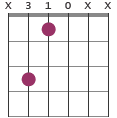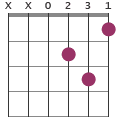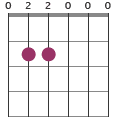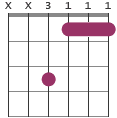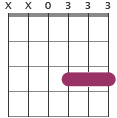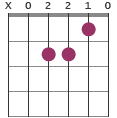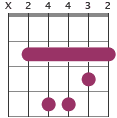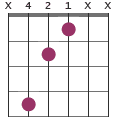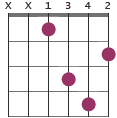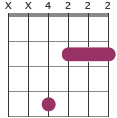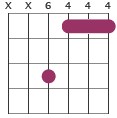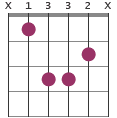Minor chords
Minor chords are together with the major chords the most important chords to learn for guitarists. This chord type consists of a root note, a minor third and a fifth. The minor third and the fifth are theoretical names and nothing you must commit to memory.
Minor chords are written with the letter for the root note followed by an "m" (for minor). Besides the basic minor chords there are other categories that also use minor in the name, such as minor 7th, minor 9th, minor 11th and minor 13th.
Basic minor chords
Chord training
Minor chord exercises (.pdf)
1a
1b
2
3
Basic minor chords with sharp or flat root
C#m / Dbm
D#m / Ebm
F#m / Gbm
G#m / Abm
A#m / Bbm
Comments
Some of the presented diagrams, primarily Cm, Fm, Bm, C#m/Dbm, D#m/Ebm, F#m/Gbm, are often played with other shapes (barre chords most of all), or with a capo. Therefore, you should check upon this and decide which way you prefer to play the chord. Click on a link below a picture for more alternatives including barre shapes and capo positions.
Notes in minor chords
The note names and the numbers of notes in various minor chords.
Numbers of notes
Cm 3 notesCm7 4 notes
Cm6 4 notes
Cm9 5 notes
Cm11 6 notes
Cm13 7 notes
Notes in chord
Cm7 C - Eb - G - BbC sharp m7 C# - E - G# - B
Dm7 D - F - A - C
D sharp m7 D# - F# - A# - C#
Em7 E - G - B - D
Fm7 F - Ab - C - Eb
F sharp m7 F# - A - C# - E
Gm7 G - Bb - D - F
G sharp m7 G# - B - D# - F#
Am7 A - C - E - G
A sharp m7 A# - C# - F - G#
Bm7 B - D - F# - A
See diagrams
Notes in chord
Cm6 C - Eb - G - ADm6 D - F - A - B
Em6 E - G - B - C#
Fm6 F - Ab - C - D
Gm6 G - Bb - D - E
Am6 A - C - E - F#
Bm6 B - D - F# - G#
See diagrams
Notes in chord
Cm9 C - Eb - G - Bb - DDm9 D - F - A - C - E
Em9 E - G - B - D - F#
Fm9 F - Ab - C - Eb - G
Gm9 G - Bb - D - F - A
Am9 A - C - E - G - B
Bm9 B - D - F# - A - C#
See diagrams
Notes in chord
Cm11 C - Eb - G - Bb - D - FDm11 D - F - A - C - E - G
Em11 E - G - B - D - F# - A
Fm11 F - Ab - C - Eb - G - Bb
Gm11 G - Bb - D - F - A - C
Am11 A - C - E - G - B - D
Bm11 B - D - F# - A - C# - E
See diagrams
Notes in chord
Cm13 C - Eb - G - Bb - D - F - ADm13 D - F - A - C - E - G - B
Em13 E - G - B - D - F# - A - C#
Fm13 F - Ab - C - Eb - G - Bb - D
Gm13 G - Bb - D - F - A - C - E
Am13 A - C - E - G - B - D - F#
Bm13 B - D - F# - A - C# - E - G#
See diagrams
Progressions with minor chords
Minor chords are most commonly played in sequences that also include major chords or other chord types. Here are some basic examples:
Em – Am – D – G
Gm – Bb – Dm – F
Am – G – C – E
C – Dm – Em – Am
Chart with minor keys
This chart is useful if you want to create a song or a chord progression in a minor key.
| Key | |||||
|---|---|---|---|---|---|
| A#m | C# | D#m | E#m | F# | G# |
| D#m | F# | G#m | A#m | B | C# |
| G#m | B | C#m | D#m | E | F# |
| C#m | E | F#m | G#m | A | B |
| F#m | A | Bm | C#m | D | E |
| Bm | D | Em | F#m | G | A |
| Em | G | Am | Bm | C | D |
| Am | C | Dm | Em | F | G |
| Dm | F | Gm | Am | Bb | C |
| Gm | Bb | Cm | Dm | Eb | F |
| Cm | Eb | Fm | Gm | Ab | Bb |
| Fm | Ab | Bbm | Cm | Db | Eb |
| Bbm | Db | Ebm | Fm | Gb | Ab |
| Ebm | Gb | Abm | Bbm | Cb | Db |
| Abm | Cb | Dbm | Ebm | Fb | Gb |
Cb = B | E# = F | Fb = E |
So how to read the table? Let's say you want to create a sequence of chords in E minor. In that case, start to look for "Em" in the first column and when you can use all the chords in the same row (in this case it would be G, Am, Bm, C and D).
Alternative chart with minor keys
Another chart, almost similar with the former.
| Key | |||||
|---|---|---|---|---|---|
| A#m | C# | D#m | E# | F# | G# |
| D#m | F# | G#m | A# | B | C# |
| G#m | B | C#m | D# | E | F# |
| C#m | E | F#m | G# | A | B |
| F#m | A | Bm | C# | D | E |
| Bm | D | Em | F# | G | A |
| Em | G | Am | B | C | D |
| Am | C | Dm | E | F | G |
| Dm | F | Gm | A | Bb | C |
| Gm | Bb | Cm | D | Eb | F |
| Cm | Eb | Fm | G | Ab | Bb |
| Fm | Ab | Bbm | C | Db | Eb |
| Bbm | Db | Ebm | F | Gb | Ab |
| Ebm | Gb | Abm | Bb | Cb | Db |
| Abm | Cb | Dbm | Eb | Fb | Gb |
The only difference is the fourth column in which the chord shift from minor to major. It's common to play this chord as a major although it will include a note outside the related scale. This chord can also sound great as a dominant 7th. What happens is that the seventh in the scale is sharpened. Let's compare the regular scale and the alternative and use the A minor scale as an example:
| 1 | 2 | 3 | 4 | 5 | 6 | 7 | 8 |
|---|---|---|---|---|---|---|---|
| A | B | C | D | E | F | G | A |
| A | B | C | D | E | F | G# | A |
The seventh degree is called the leading tone. The leading tone resolves into the tonic and by rising it the movement from it to the tonic become stronger. In the table above, you can see that E is used instead of Em as the fourth chord for the Am key. E includes E, G#, B whereas Em includes E, G, B. A chord progression to illustrate this is: Am - Dm - Am - E.
Digital poster
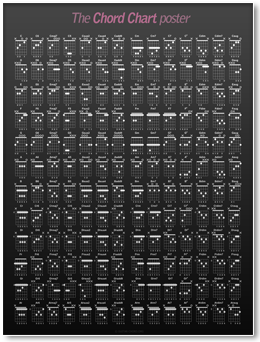
The Chord Chart Poster includes a selection of the 100+ most important chords for guitar.
